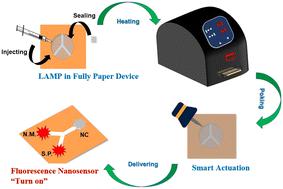Our official English website, www.x-mol.net, welcomes your
feedback! (Note: you will need to create a separate account there.)
A microfluidic fully paper-based analytical device integrated with loop-mediated isothermal amplification and nano-biosensors for rapid, sensitive, and specific quantitative detection of infectious diseases
Lab on a Chip ( IF 6.1 ) Pub Date : 2022-11-03 , DOI: 10.1039/d2lc00834c Hamed Tavakoli 1 , Elisabeth Hirth 1, 2 , Man Luo 1 , Sanjay Sharma Timilsina 1 , Maowei Dou 1 , Delfina C Dominguez 3 , XiuJun Li 1, 4, 5
Lab on a Chip ( IF 6.1 ) Pub Date : 2022-11-03 , DOI: 10.1039/d2lc00834c Hamed Tavakoli 1 , Elisabeth Hirth 1, 2 , Man Luo 1 , Sanjay Sharma Timilsina 1 , Maowei Dou 1 , Delfina C Dominguez 3 , XiuJun Li 1, 4, 5
Affiliation

|
Bacterial meningitis, an infection of the membranes (meninges) and cerebrospinal fluid (CSF) surrounding the brain and spinal cord, is one of the major causes of death and disability worldwide. Higher case-fatality rates and short survival times have been reported in developing countries. Hence, a quick, straightforward, and low-cost approach is in great demand for the diagnosis of meningitis. In this research, a microfluidic fully paper-based analytical device (μFPAD) integrated with loop-mediated isothermal amplification (LAMP) and ssDNA-functionalized graphene oxide (GO) nano-biosensors was developed for the first time for a simple, rapid, low-cost, and quantitative detection of the main meningitis-causing bacteria, Neisseria meningitidis (N. meningitidis). The results can be successfully read within 1 hour with the limit of detection (LOD) of 6 DNA copies per detection zone. This paper device also offers versatile functions by providing a qualitative diagnostic analysis (i.e., a yes or no answer), confirmatory testing, and quantitative analysis. These features make the presented μFPAD capable of a simple, highly sensitive, and specific diagnosis of N. meningitis. Furthermore, this microfluidic approach has great potential in the rapid detection of a wide variety of different other pathogens in low-resource settings.
更新日期:2022-11-03











































 京公网安备 11010802027423号
京公网安备 11010802027423号